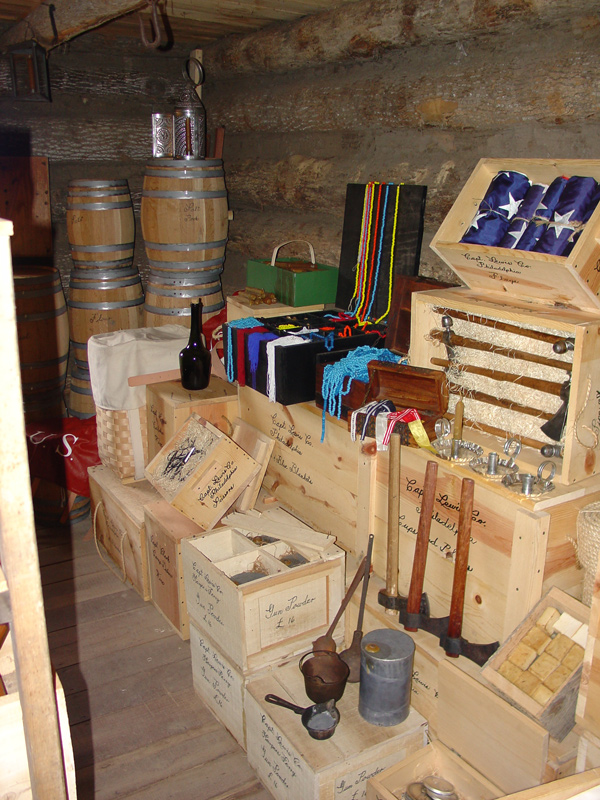Almost one-third of the $2,160 Lewis spent on purchases by Israel Whelan went for Indian gifts.
Indian Gifts and Expedition Equipage
Photo provided by Lewis & Clark State Historic Site, Hartford, Illinois. Used by permission.
Not knowing exactly how many Indian tribes they would encounter, especially between the Knife River Villages and the Pacific Coast, the captains could only make a semi-educated guess as to how much to carry in the way of gifts and trade goods. Almost one-third of the $2,160 Lewis spent on purchases by Israel Whelan went for Indian presents, not only to supply some of the Indians’ anticipated wants but also to showcase some of the more attractive goods they might learn to want. The captains’ lists consisted of 51 individual types of items altogether. It was in part an inventory of everyday items in Philadelphia shops, some with names that are especially intriguing today, such as the “nonesopretty,” a silk ribbon embroidered with patterns that Lewis expected would delight Indian women. On the day before the party was to set out up the Missouri from Camp Wood River, Clark pensively noted in his brief journal entry that they had “such articles of merchendize as we thought ourselves authorised to precure—tho’ not as much as I think necssy for the multitud of Inds. tho [through] which we must pass on our road across the Continent.” His judgment was correct. By the time the Corps left Fort Clatsop en route home they were already trading off their dress uniforms, and giving buttons to Indians in return for food.
One commodity Lewis did not think of back in Philadelphia was “hairpipes” (Fig. 1), which were tubular beads, of bone, shell, copper or stone usually 1½ inches or more in length, of the type that had been manufactured by Indians as costume decorations since pre-Columbian times. At the last minute Lewis managed to find 24 hairpipes for sale in St. Louis— a paltry number considering the widespread evidence of hairpipes’ continuing popularity. During the 19th century the hairpipe became increasingly important to the Indian trade. It was turned out in huge quantities by cottage industries such as that of the Campbell family in New Jersey, whose products were made from the lip of the West Indian conch, Strombus gigas. Hairpipes were sometimes referred to as wampum, from an Algonquin Indian expression wampampiak, signifying “string of (white) beads.” Wampum was used for its cash value by white traders, but Indians regarded hairpipes as symbols of the wearer’s social or political status.
Experience the Lewis and Clark Trail
The Lewis and Clark Trail Experience—our sister site at lewisandclark.travel—connects the world to people and places on the Lewis and Clark Trail.
Discover More
- The Lewis and Clark Expedition: Day by Day by Gary E. Moulton (University of Nebraska Press, 2018). The story in prose, 14 May 1804–23 September 1806.
- The Lewis and Clark Journals: An American Epic of Discovery (abridged) by Gary E. Moulton (University of Nebraska Press, 2003). Selected journal excerpts, 14 May 1804–23 September 1806.
- The Lewis and Clark Journals. by Gary E. Moulton (University of Nebraska Press, 1983–2001). The complete story in 13 volumes.


